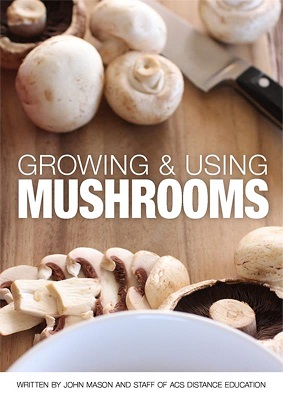Extract from a new ebook published October 2016
 There are four stages in the growing of mushrooms, briefly outlined below:
There are four stages in the growing of mushrooms, briefly outlined below:
Stage 1: Preparation of Spawn and Substrate
Spawn is obtained (i.e. microscopic particles which germinate like seed and grow into the mushroom plant). Spawn can be purchased in sealed containers, or if you buy a pre-packaged mushroom kit, the spawn may already be planted in the substrate. You can also produce your own spawn but it is a complicated and highly scientific process (discussed in following chapter).
A bed or container is filled with a substrate suitable for growing mushrooms in is prepared. The substrate, also called compost, must be very rich and may contain a lot of well-rotted animal manure. Lime is normally added to reduce the acidity (i.e. bringing the pH to between 7.5 and 8.5).
Stage 2: Planting (i.e. Spawning)
The spawn is removed from the sealed jar and broken up into 1cm diameter pieces. It is then planted about 2cm deep and 25cm apart. It should be keep moist, but not saturated. Light is not needed, but cool, dry, draught-free conditions are needed if production is to be good. The ideal temperature during this stage is between 22 and 25°C. High humidity is also preferable at this stage.
If temperatures are lower, growth will be slower. Because of these requirements mushrooms are frequently grown in a shed, or under the house. On a commercial basis they are grown is climate-controlled, specifically designed and constructed facilities. Growing trays are sometimes stacked on shelves to save space.
Stage 3: Casing
Casing involves covering the substrate/compost with a protective layer of moist material - for example: peat and lime, vermiculite, or other suitable material (in the past, soil was used).
The casing is a non-nutritious (usually), inert, moisture-holding layer that is used to cover the colonised substrate. Mineral supplements such as gypsum, hydrated lime, lime, and often crushed oyster shells are added to the casing. The most common material used is a mix of peat moss and lime, or coir fibre and lime. Vermiculite is also another popular casing. The covering protects the substrate and holds in the moisture, and this in turn induces fruiting and the development of the mushrooms.
Common casing materials:
- Vermiculite - cheap, totally inert and can hold up to 16 times its weight in water.
- Peat moss - is an acidic material that is also commonly used, but you need to add lime to bring up the pH to neutral (pH7) to slightly alkaline (pH8).
- Coir fibre – made from the shells of coconut husks, very water retentive and also adds nutrition. It is also often used in the bulk substrate but does encourage the growth of
- mycelium over the casing layer.
Casing mixes:
The casing can also be a mix of the above, for example:
- 50:50 peatmoss to vermiculite
- Coir fibre 60% to vermiculite 40%
- A mix of the 40:40 peat moss to vermiculite with added agricultural hydrated lime (5%) and crushed oyster shells (15%)
The time of casing varies. It might be only a couple of days after planting, or several weeks after planting. Temperatures at this stage are best to be a little lower than in the spawning stage, preferably around 15°C.
Fresh air and evenness of temperature and humidity are important. Though the mushrooms will probably crop without it, they will benefit from a fan being placed in the room with them after casing. Low watt fans can be run almost 24 hours a day for a few weeks with little impact on your electricity bill.
Stage 4: Harvest
Mushrooms should be ready to harvest between 6 and 10 weeks after planting. The crop appears in flushes. Normally a flush will be harvested over 3 to 4 days. The bed is then left for a couple of weeks, and a second flush will appear. Flushes may continue for months, or taper off within weeks depending on conditions. Mushrooms can develop quickly once they appear. Once ready for picking, they must be picked. Delaying picking by only 24 hours can result in significant deterioration.
Click here to see our ebook on mushrooms.